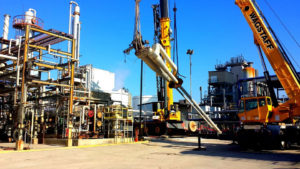Whether you’re a potential investor or someone who’s making a living in the oil and gas industry, the number of new technological advances in this industry is accelerating. Here are a few of the changes that are coming down the pike.
Utilizing Robots and Autopilot Vehicles
 These two things are making a huge difference in every aspect of the modern world, and the oil and gas industry is no different. Relying on autonomous vehicles, robots, and other AI-based devices means that fewer people need to be hired doing potentially dangerous activities. AI helps oil and gas companies by developing algorithms that provide accurate and precise intelligence to guide drills on water and land. Precision drilling helps in reducing the risk of accidents, oil spills, fires, and enhances the rate of penetration.
These two things are making a huge difference in every aspect of the modern world, and the oil and gas industry is no different. Relying on autonomous vehicles, robots, and other AI-based devices means that fewer people need to be hired doing potentially dangerous activities. AI helps oil and gas companies by developing algorithms that provide accurate and precise intelligence to guide drills on water and land. Precision drilling helps in reducing the risk of accidents, oil spills, fires, and enhances the rate of penetration.
What’s even better is that robots aren’t just the best thing happening to this industry right now, but will also continue making a massive impact in the future as well. Robotics will revolutionize every part of the process, from production to quality control and everything in between, and only those who embrace these advancements will be able to continue making a profit. Therefore, be sure to look into different IT options available to you and make the most of their potential.
Making Things Greener and Safer
Knowing that we’re living in an age of environmental problems and ecological disasters, individuals running the oil and gas companies are doing their best to make a positive difference. Accidents can be monitored from AI-powered cameras, robots, drones, etc to reduce the extent of potential damage.
Companies like Green Clean are developing solutions that clean and degrease as well as optimizes production wells. G-Clean® can improve the environment while also improving the oil and gas industry’s profitability.
Safe Influx is a ground-breaking new technology to help avoid well blowouts by automating well control operations and removing the human risk factor associated with well control.
Relying on New Equipment and Technology
In an industry where a failure that causes downtime can cost you millions in lost revenue companies insist on the finest oilfield equipment. Given the increasing trends in longer horizontal well sections with reduced spacing between stages, conventional well integrity methods are reaching their technical limits. So Schlumberger developed the “CemFIT Shield system” to provide the industry’s first zonal isolation technology specifically designed to improve isolation between hydraulic fracturing stages in long horizontal wells.
Scientists and oil companies alike believe that microwave fracking could be “the next big thing”. According to QMast “microwave fracking works in a much less invasive, more technologically advanced way: A special drill is inserted into the ground rock where oil shale lies. The drill releases microwave frequencies, roughly the equivalent of 500 household microwave ovens into the earth. This agitates the area around the drill, super-heating the rock and turning the water and oil liquids into steam and gases, which move upward through the “well” to the surface. Once the rock immediately adjacent to a drill is fully extracted, microwaves can penetrate further away from the drill to harvest a larger area with only one well.”
Using drones more extensively
Speaking of new technological improvements, you mustn’t forget the drones. Drones are used for remote monitoring and surveillance, inspection and predictive maintenance, tracking changes, methane management, emergency response, and material handling. This helps oil and prevent injuries and disasters, which is vital for their everyday work and maintaining a positive image in the public.
Finally, a few more technological advancements you need to know about include moving all databases to the cloud, updating safety and onsite security, introducing the big data and the Internet of things concepts into this industry, as well as exploring horizontal drilling that might easily end up being the future of the entire oil and gas industry.
You might also like:
